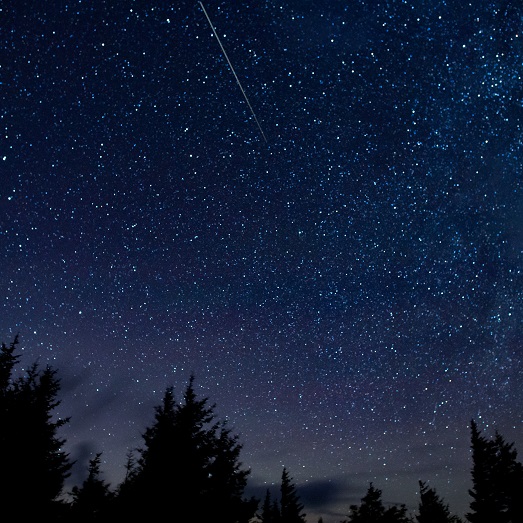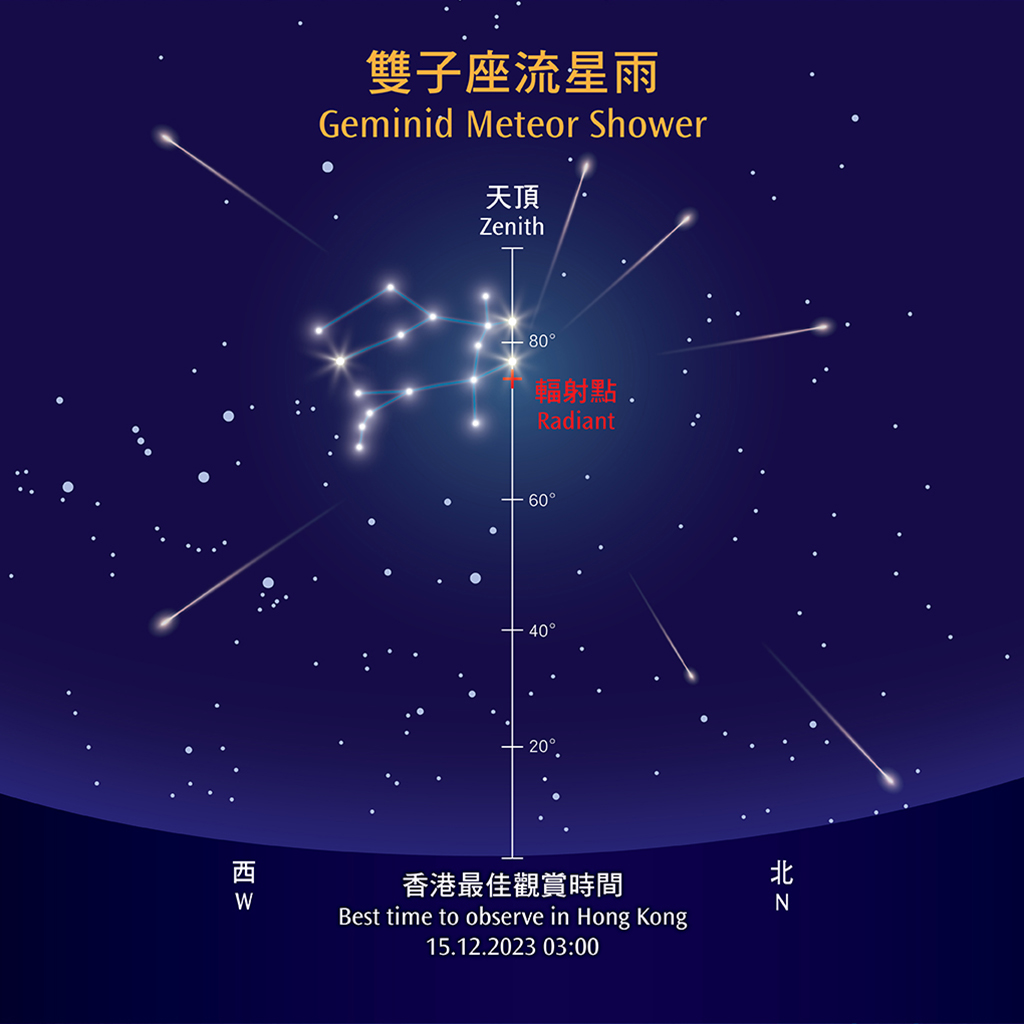 Web Content Display
Web Content Display

Meteor Shower
Tab Menu
 Web Content Display
Web Content Display

The Geminid meteor shower is active between 4 and 20 December this year, reaching its peak on 14 December. It is estimated that the Zenith Hourly Rate (ZHR) of the meteor shower can reach 150 during the peak period.
On 14 December, the radiant of the Geminid meteor shower will rise in the northeast at about 7:30 pm. Meteors can be seen when the radiant is above the horizon. The influence of moonlight will be negligible, resulting in favourable observation conditions. The radiant of the Geminid meteor shower is close to the zenith at 3:00 am on 15 December. More than 15 meteors may be seen per hour in remote areas.
The Geminids are comparatively bright, slow in speed, rich and stable in number, which makes them spectacular for visual observation. The Geminid meteor shower is one of the few meteor showers caused by an asteroid instead of a comet. Its parent body is an asteroid called 3200 Phaethon. The Geminids result when large amounts of debris scattered by Phaethon along its orbit fall into the Earth's atmosphere. Since this debris comes from the same source, all meteors will emanate from the same point called the radiant.
 Web Content Display
Web Content Display
| Date and time | Zenith Hourly Rate* |
|---|---|
| 4 pm, 14 December | 150 |
* The Zenith Hourly Rate (ZHR) is the extrapolated hourly rate of meteors observable in an extremely dark and wide sky with the radiant located at the zenith. As some meteor showers have very short peak periods, observers sometimes extrapolate the number of meteors observed in ten and a few minutes to an hourly number in proportion. Therefore, the Zenith Hourly Rate cannot be regarded as the actual number of meteors visible in one hour. Yet, it can be used as a meaningful comparison between the activities of different meteor showers. Some meteor showers can be as inactive as having single digit Zenith Hourly Rate. There are "three major meteor showers" (Quadrantid meteor shower, Perseid meteor shower, and Geminid meteor shower), which have the ZHRs reaching 100 or even higher values, and hence worth watching.
(Source: International Meteor Organisation)
Replay the live streaming of the Geminid meteor shower 2025 on HKSpM YouTube Channel.
 Web Content Display
Web Content Display
 Web Content Display
Web Content Display
Here are some tips for watching the Geminids:
- Predictions of the peak and the number of meteors are always prone to uncertainties. For those who are genuinely interested in observing the Geminids, it may pay off if you keep a watchful eye on the sky 1 to 2 days before and after the predicted peak.
- In mid-December, the radiant of the Geminid meteor shower will rise in the northeast at around 7:30 pm and reach the zenith between 2 am to 3 am. If the effect of moonlight is neglected, the closer the radiant point is to the zenith, the more meteors will present.
- Although the radiant of the meteor shower will be in the constellation Gemini, meteors do not necessarily appear near the radiant. Observers should choose a site with an unobstructed view and low light pollution.
- Although going to the countryside can definitely let you see more dim meteors, city stargazers may be restrained from doing so by factors like traffic, weather, or the need of going to work or school on the following day. An open place near home with an unobstructed view may also do the trick. Please try to stay away from any light source to preserve the sensitivity of your eyes to weak light.
- Basically, a telescope is not required as meteors are better observed by naked eyes. You may bring along with you a star-map, a red torch, a deck chair and a sleeping bag or blanket. Please observe stargazing manner and refrain from using excessive light as this will affect other stargazers.
- To photograph meteors, a camera with long-exposure function and a wider angle lens are essential. After focusing on starlight, point the camera to the zenith or the darkest area on the sky and set an appropriate aperture and ISO value (such as F2.8 or lower, ISO 800 or higher, depending on the design of the lens and camera, as well as the nearby environment). Then select the time of exposure based on whether a star tracker is used. In general, a longer exposure gives you a higher chance of capturing unexpected meteors. For long exposure, you may consider stepping down the aperture (to say, F4 or F8) and ISO value (such as ISO 400) for better image quality. The image distortion due to camera shaking can be resolved by using a remote control or the shutter delay function of the camera.
